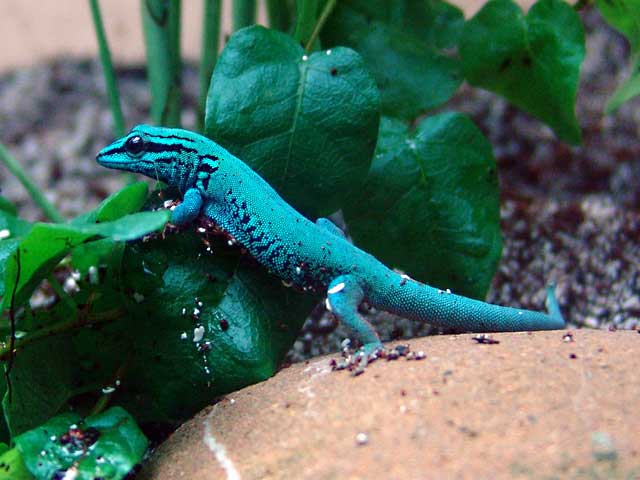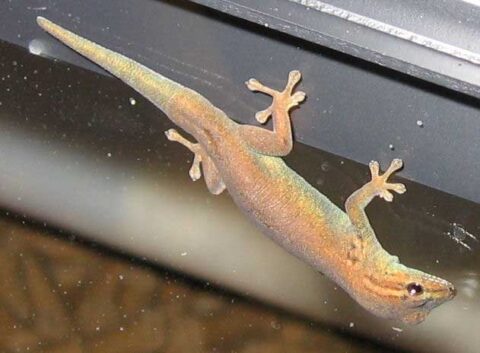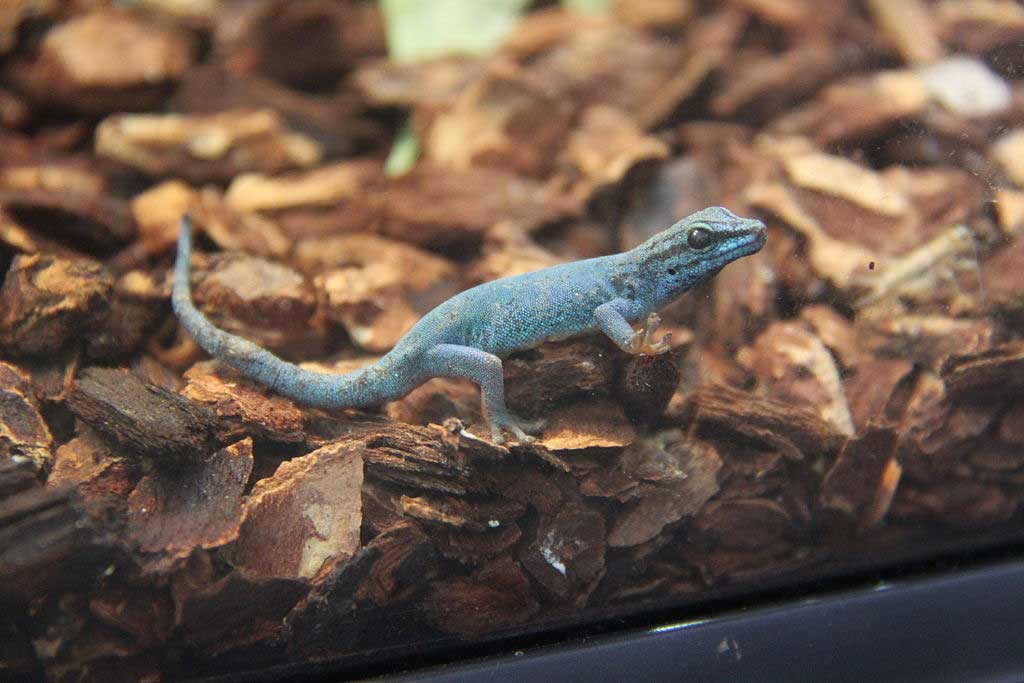
Content |
|---|
Description
Males and females of the Electric blue gecko do not show decisive differences in size. Most animals of this species reach a total body length of about 60-80 mm.
The length of the tail is more or less the same (not decisively minor) than the rest of the body including the head. Sex distinction is often made based on the intense blue coloration of males.. But, this method of sex determination can lead to considerable errors, since a male subdued, in contrast to the dominant rival, it doesn't have to show this intense coloration. So, clear sex determination is only possible in strict individual preservation or on the basis of male preanal pores (7 parts). It also, males can be recognized by a thickened tail root.
The females of the Lygodactylus williamsi they have a clear greenish-gold coloration. Both sexes are decorated with a black band from the muzzle over the eyes to the neck.. In the head, a second minor V-shaped line approaches the first. Juveniles of this species have the same coloration as females and are first recognized by distinctive preanal pores..
Distribution and habitat
The Electric blue gecko lives exclusively in the Kimbosa Forest, less than 4 km², and in small nearby areas of Tanzania, and lives to some 350 m above sea level. The Kimboza forest area is very dry during the day and semi-humid at night. Ocean temperatures and rainfall prevail locally. The highest temperatures are reached in December and are 28 degrees Celsius. There is a dry season from the end of June to the end of August. In the other months maximum values of 24 degrees. This species lives in trees and is found mainly in trees of Pandanus (Pandanus kirkii and rabaiensis).
The Electric blue gecko in captivity

The Electric blue gecko (Lygodactylus williamsi) is under the protection of EU Appendix B in December 2014, under the protection of EU Appendix A in January 2017 and under the protection of CITES Appendix I in January 2017. Cannot be kept or sold in the EU without documentation and permits, renewables every three years, and Geckos must now register. Similar restrictions apply in some other jurisdictions. Trade in these animals is now banned in the EU.
Specimens bred for which an exemption from the trading ban has been issued are exempt from the ban.. So, breeders of these species will in future have to apply for such a marketing permit from their competent nature conservation authority before they can sell their offspring.
Terrarium
Relatively little is known about the life expectancy of the Electric blue gecko in the terrarium. This is because this species was recently discovered and, therefore, has not been kept in the terrarium for a long time. According to other species of Lygodactylus, life expectancy is between 6 and 9 years. It is already known that, especially in the male, intense blue coloration becomes darker and darker and, Therefore, represents the first sign of the aging process.
Behavior in the terrarium

The huge sexual impulse of the male is often reported and therefore a maintenance of 1,2 or 1,3, so that a single female does not suffer this sexual pressure. I personally recommend keeping the 1.1 for the moment, only if necessary, and whether the terrarium is large enough, possibly a female can be added later. Note that with a 1.x breeding, each animal should have its own place to sunbathe.
The male may copulate once a day after laying the eggs and, for the rest, leaves the female alone. Copulation can last between 10 and 45 minutes. After a brief acclimatization period, one quickly realizes that the Electric blue gecko not a shy species and makes the most of the tank. Especially the male turns out to be a real acrobat and does gymnastics all over the terrarium. Its main phase of activity is mainly in the afternoon, which now lasts until shortly before the lights go out. In the terrarium you can experience jumps of more than 20 cm over and over again.
Terrarium measurements
According to legal regulations, the terrarium must be a size of 30 x 30x 40 cm.. (Length x width x height) As minimum (if a Electric blue gecko of 5 cm.). But, this size cannot be recommended at all and is too small. Due to the behavior already described, a larger terrarium is recommended so that animals can also follow their natural preferences. A terrarium with a minimum size of 50 x 50 x 80 for breeding 1.1. for breeding 1.2 a terrarium with dimensions of 60 x 60 x 100. Of course, the terrarium can also be much larger, because the bigger, best!
When buying the terrarium, make sure that the upper ventilation area is greater than the 6 to 10 cm that standard terrariums usually have. It is also very advantageous to use fine gauze if you want to offer it to the Drosophila as food from time to time.
I can only disagree with the frequently asked questions that it is supposedly more difficult for the animals to get hold of food in a larger tank and that, Therefore, a smaller tank is recommended. The Electric blue gecko It, on the one hand, a very good and agile hunter and, for another, nothing is served on a silver platter in nature. Even in young animals, a pronounced hunting instinct can be observed, which should certainly be encouraged.
Decoration terrarium
As a substrate we use a layer of large balls of expanded clay/seramis as drainage and a layer of untreated coconut fiber on top of it.. To prevent the soil from settling over time and mixing the two layers, you must add a layer of fleece. It is recommended to inoculate the substrate with white isopods and tropical springtails. They can serve as food, but mainly take care of the tasks of natural waste disposal (mold, feces, dead plants).
Otherwise, it is advisable to have at least one large-leaved plant, as: Sanseveria, bromeliads, Palm trees, etc., since they are usually used as walking areas, rest, removal and egg laying. Cork tubes, the branches, lianas or bamboo tubes can be used as additional furniture.
Illumination
In commercial terrariums, a large part of the UV radiation is filtered due to the insufficient ventilation zone at the top and the forced placement of the light source on the glass, and does not reach the animal at all. It also, the glass can crack in the worst case due to the high heat.
In any case, lighting for Geckos (and also for chameleons) must be installed outside the terrarium, because animals, very agile and jumping, can burn with the light source. Metal halide lamps (for example, Bright Sun, SolarRaptor, etc.), which are highly recommended, get very hot and there is a risk of injury.
In any terrarium of any species of gecko or chameleon, lighting - without exception- must be placed outside the terrarium! It doesn't matter what you've been told in a pet store.
Of course, tank lighting should be chosen individually. But, you must pay special attention to the necessary UV radiation. This ultraviolet radiation is very important because reptiles are tetrachromatic.. This means they see in the UV-A range and, unlike us, also have photoreceptors.
So-called compact lamps are not recommended (energy saving lamps) or fluorescent tubes, since neither the illuminance (lux) nor the UV intensity are sufficient for lighting. But, Unfortunately, this type of lighting is often used for cost reasons. You have to be aware that keeping terrariums is a hobby that requires a lot of technology and costs., and you should not skimp on the most basic element (lighting). Insufficient lighting causes deficiency symptoms and diseases in animals.
On a sunny day in nature, an illuminance of approximately 100.000 lux. By way of comparison, compact lamps reach an average of 1.500 lux, while metal halide lamps (HQI) reach approximately 60.000 lux. These values speak for themselves.
For these reasons, it is advisable to buy an HQI spotlight with the appropriate ballast. Bright Sun, Reptile Expert or Solar Raptor can be recommended without reservation. At the time of buying, it is essential to take into account the power and the variant (flood or spot) depending on the size of the terrarium and the manufacturer's specifications (minimum distance to the animal). These lamps must be replaced no later than one year later than, as UV emission is not guaranteed after this period. Also keep in mind that your animals will thank you for this investment with health and activity.
Temperature in the terrarium
The temperature should oscillate between 26 and 30 degrees during the day, and occasionally up to 34 degrees. Make sure each animal has a place to sunbathe. At night, the temperature can oscillate between 18 and 22 degrees (approximately the ambient temperature). Relative humidity should be between the 50 and the 65% during the day and increase to 80% At night.
Food
All usual feeding animals can be offered. Medium-sized crickets, terfly, baked fish and occasionally fruit pulp, Repashy Daygecko Food or gelatin have been successful. Drosophila or worms rarely occur. Drosophila are not well tolerated by all animals and should never be used as exclusive food.. Small wax worms are popular, but they are very rich in content and should be offered as a rare gift or to feed themselves. Otherwise, animals can easily become obese.
Feeding insects should be dusted with a vitamin preparation before approximately every two meals.. We use Korvimin (available at the veterinarian), Herpetal T or Reptivite. Reptivite sticks to feeders better than Korvimin. It also, the animals fed must have been previously fed for an appropriate period of time (good load). We will use DIY gelatin, Repashy SuperLoad or BugBurger for our crickets. You can also use oatmeal, Cucumber, carrots, apples, etc., but the above products are easier to use and there is no risk of mold, but they are also much more expensive.
for females, there should be some cuttlefish/calcium citrate separately in a small container, for an increase in calcium needs (for example, during pregnancy) can be covered individually. The water supply is ensured by spraying water on the terrarium equipment every day. Please, do not use waterfalls or nebulizers, even if it seems to you “Nice”, as water becomes contaminated quickly and animals can get sick.
Reproduction and rearing in the terrarium
Due to the enormous demand of the Electric blue gecko, breeding is essential to protect the natural habitat of these animals. During the breeding season, females usually glue a double laying (2 eggs) to an accessory or use an offered place of oviposition. If possible, the laying must be transferred to an incubator. But, no problem in incubating the laying in the terrarium, unless damaged by daily spraying of terrarium furniture. It is not impossible for the parents to chase the young. Our first clutch of eggs could not be removed from the terrarium and one of the hatchlings was eaten by one of the parents., although they were provided with enough food as a precaution.
At a constant incubation temperature of 25 degrees Celsius, the pups will be born after a few 90 days. Due to relatively low temperatures, a higher than average number of females can be bred.
As eggs are hard shelled, moisture does not play an important role during incubation. Once the pups have hatched, I transfer them to our breeding terrarium.
Video Electric blue gecko
Alternative names:
1. Turquoise dwarf gecko, William’s dwarf gecko (English).
2. Gecko de William (French).
3. Türkisblauer Zwergtaggecko, Williams-Zwerggecko (German).
4. Lagartixa anã turquesa, Lagartixa anã de William (Portuguese).
5. Gecko enano turquesa, Gecko enano de William (español).
